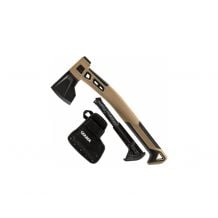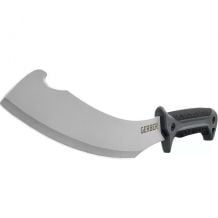Sign in
Contact
Machetes / Axes
-

 NewOut of stockSerpe Silky Nata - Outback Edition (Black)134.00 €
NewOut of stockSerpe Silky Nata - Outback Edition (Black)134.00 € -


 Bushcraft axe Morakniv Outdoor Axe52.69 €-15%
Bushcraft axe Morakniv Outdoor Axe52.69 €-15% -

 Hatchet Gerber Bushcraft Hatchet (Coyote)61.12 €-15%
Hatchet Gerber Bushcraft Hatchet (Coyote)61.12 €-15% -

 Machete Gerber Broadcut large47.90 €-25%(1)
Machete Gerber Broadcut large47.90 €-25%(1) -

 Machete Gerber Freescape Hatchet 17.5'' (Black/Green)73.01 €-15%
Machete Gerber Freescape Hatchet 17.5'' (Black/Green)73.01 €-15% -

 Machete Gerber Versafix Pro (Red)42.41 €-15%(2)
Machete Gerber Versafix Pro (Red)42.41 €-15%(2) -

 Hachette Stoke Sol44.12 €-15%(1)
Hachette Stoke Sol44.12 €-15%(1) -

 Machete Gerber Compact Clearpath (Black/Orange)33.90 €-24%(4)
Machete Gerber Compact Clearpath (Black/Orange)33.90 €-24%(4) -

 Machete Gerber Gator Bush49.90 €-28%(4)
Machete Gerber Gator Bush49.90 €-28%(4) -

 Machete Gerber Bolo (Black)59.42 €-15%
Machete Gerber Bolo (Black)59.42 €-15% -

 Machete Gerber Kukri (Black)50.92 €-15%
Machete Gerber Kukri (Black)50.92 €-15% -

 Machete Gerber Gator Machete Jr (Black)35.62 €-15%(2)
Machete Gerber Gator Machete Jr (Black)35.62 €-15%(2) -

 Machete Gerber Gator Machete (Black)44.90 €-25%(5)
Machete Gerber Gator Machete (Black)44.90 €-25%(5)
How to choose the right survival machete and axe?
The different types of machete
-
Kukri machete: Dating back over 2000 years, the Kukri machete is distinguished by its inwardly curved blade. This shape gives this Nepalese machete remarkable versatility in terms of survival and combat. It enables powerful strikes for chopping wood and can easily replace a hatchet or a large survival knife.
-
Bolo machete: Widespread in the Philippines, the Bolo machete features a wider, rounded blade, making it ideal for cutting wood. With a blade length of typically 40 cm, it offers excellent inertia and power for effortless cutting.
-
Latin machete: This lightweight, straight-bladed machete is widely used. It is particularly effective for light work, clearing undergrowth and forestry activities. Sometimes referred to as a "jungle machete", its long blade makes it easy to clear a path or defend oneself in a pinch.
-
Bowie machete: Equipped with a clip-point blade, the Bowie machete is easy to handle and enables effective perforation. It's the ideal tool for overcoming obstacles. The Cold Steel model is particularly popular and affordable.
-
Gator machete: The Gator machete offers unique versatility thanks to its ability to saw with the back of the blade. It's ideal for forest excursions, whether you're preparing a fire or building a shelter.
-
Golok machete: Originating in Indonesia, the Golok machete was originally a military weapon. With its thick blade and curved handle, it is robust and powerful. This machete is ideal for bushcraft, enabling efficient clearing, cutting and pruning.




















